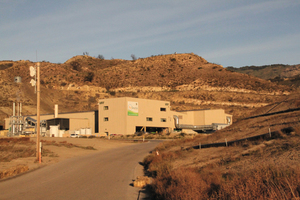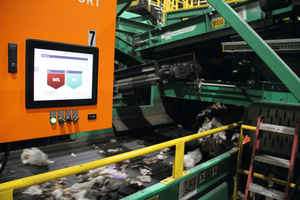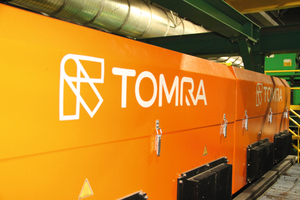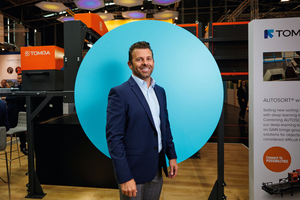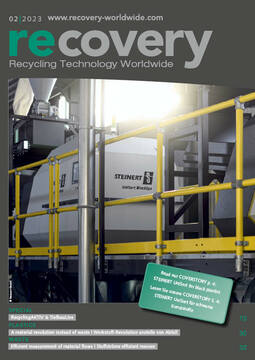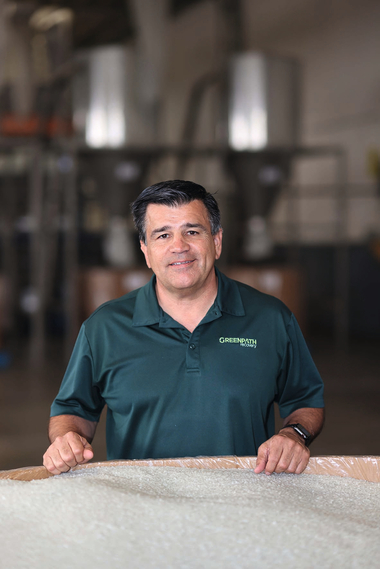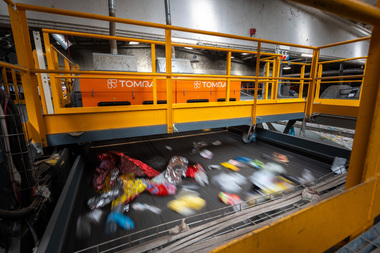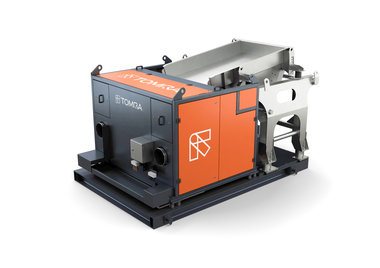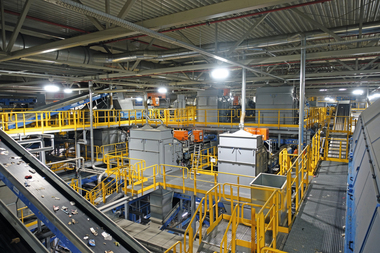Quick-change mixed waste processing
Santa Barbara County’s Resource Center efficiently sorts both MSW and single stream using the same circuit with TOMRA AUTOSORT™ units to successfully reduce landfilling.
Santa Barbara County’s Resource Center in California may quite possibly be a model of efficiency for future material recovery facilities (MRF) in North America. Conceptualized roughly 20 years ago, the mixed waste processing facility at the Tajiguas Landfill site, in operation since 2020, is designed to meet the state’s stringent organics recycling diversion targets set for 2025. Plus, it recovers valuable recyclable commodities from municipal solid waste (MSW) that would have been landfilled just a couple of years ago.
“What makes the facility unique is it must sort all materials before disposing in the landfill,” says Wilfred Poiesz, recycling system design and sales manager for VAN DYK Recycling Solutions, Norwalk, Conn, the MRF builder. “It runs both MSW and single stream on the same circuit.” Beyond this, Carlyle Johnston, project leader at the County of Santa Barbara, adds, “We have the landfill, MRF, organic anerobic digestion facility, mulcher and compost at this site. We are the only facility to have all these operations sited at one location.”
A green solution for organics
Dubbed the biggest change to happen in waste management in over 30 years, California’s SB 1383 targets organic waste to reduce short-lived climate pollutants in the state. It requires the state to reduce 75 % of organic wastes – food, green waste, paper products, among others – by 2025. In 2018, California disposed of approximately 24 million tons of organic waste, and the mandate targets to reduce this by more than 20 million tons by 2025.
The recovery facility’s design was, in part, geared toward meeting those mandates. The Tajiguas Landfill serves the South Coast and the Santa Ynez and New Cuyama Valleys’ commercial and residential waste services. “We serve approximately 220 000 people,” offers Johnston. “Santa Barbara is an affluent county, and the general rule is waste generation increases with affluence. Waste generation for county residents averages 4 kg/person.”
The facility first shreds MSW to break apart and resize materials before being processed. “The automated circuit handles material between 6.35 to 35.56 cm,” explains Poiesz. After shredding, a series of trommels and screens sizes the material. Any heavy material falling through the 2.5-inch screens is treated as organics and sent to the anerobic digesters. It is converted into compost and biogas for electricity.
Johnston explains the importance of removing organics from landfilled materials. “Decomposing organics emits methane gas, which is a short-lived climate super pollutant 25 to 100 times more potent as a GHG than carbon dioxide (CO2). In addition to biogas, the site also employs solar and landfill gas for our power needs to make us self-sustaining plus a donor to the grid.” Commenting on the success of the landfill to reduce greenhouse gas (GHG) emissions, he added: “This facility is the single largest reducer of GHG in the county. We are reducing 117 000 metric tons of CO2 annually, which is equivalent to taking 28 000 cars off California’s roads.”
Profiting from commodity recovery
With approx. 6100 m² under roof for tipping floor space, Alan Coulter, general manager for MarBorg Recovery, operator of the Resource Center’s MRF, says space is tight. “We can’t keep material sitting on the floor for too long. We must keep it flowing from the floor to the circuit,” he says. Poiesz mentions the automated sorting circuit’s designed capacity is 1000 tons per day. “We currently run, on average, 800 tons per day of both MSW and single stream,” adds Brandan Fix, operations manager for MarBorg.
The screening process also separates oversized material greater than 35.56 cm, diverted from the automated circuit for manual sorting. “Our goal is for quantity of material removed from the stream, so we employ manual sorters to help maximize material recovery,” offers Coulter. Johnston further explains, “We have a 60 % contracted diversion rate from the landfill for MSW material.”
The remaining 6.35 to 35.56 cm waste material is sent through a series of 10 TOMRA AUTOSORT™ units for recovery of valuable recyclable commodities, including plastics, plastic film, paper and wood. Ty Rhoad, regional director Americas for TOMRA Recycling Sorting explains, “MSW contains valuable secondary raw materials. If they are recovered through mixed waste sorting and further recycling, we take circularity and greenhouse gas (GHG) benefits to new heights.”
As a preferred supplier for TOMRA sorting technology in North America, VAN DYK has extensive experience incorporating flexibility into their system designs. The recovery facility’s designer and installer focuses on “future proofing” MRFs, helping them to adapt to market changes both today and many years down the line. The facility was designed to be able to capture any commodity to keep up with the evolving tonnage. To confirm this point, Johnston adds, “We are now recovering a PP#5 product for sale, and that market didn’t exist when the facility was in development.”
Compact and highly flexible, the TOMRA AUTOSORT™ multifunctional sorting system can be used across a range of material sorting applications, including MSW, single stream, plastics, and E-Scrap. The new generation AUTOSORT™ incorporates the latest TOMRA technologies to offer advanced accuracy of complex sorting tasks, such as pulling recyclate from MSW feed material, at high throughput rates.
Using near infrared (NIR) and visible light spectroscopy (VIS) to identify objects, AUTOSORT™’s SHARP EYE™ technology increases light efficiency while maintaining the same energy consumption to advance sorting sharpness and improve separation of difficult to target fractions. The sorters also include TOMRA’s patented FLYING BEAM™ sensing technology to offer better light efficiency, flexible and easy installation, and enhanced light signal efficiency for improved detection. Combined, SHARP EYE™ and FLYING BEAM™ help to consistently deliver high performance sorting accuracy across all target fractions. “Automation and the TOMRA sorters are the most consistent part of the operation,” comments Coulter.
VAN DYK designed the Resource Center’s circuit to use a positive sort, where the desired recyclable material fractions are ejected by the valve blocks, to increase recovered material purity. Each AUTOSORT™ unit is equipped with three to four different “recipes” of materials that operators can select to recover from the unit. “AUTOSORT™ can be configured with dozens of recipes for recovered materials. TOMRA collaborated with VAN DYK to configure the sorters according to the customer’s needs, and then VAN DYK installed the units, programming them with the required recipes,” offers Parker Bynum, western area sales manager for TOMRA Recycling Sorting. Fix adds, “We are impressed with the flexibility of programming to quickly change recipes to fire on different material.”
Quick switch to single stream
MarBorg runs MSW through the automated sorting circuit throughout the day, and it sorts single stream recyclable material during the second shift. The circuit only shuts down for approximately 30 to 45 minutes to allow workers time to clean the screens and change AUTOSORT™’s recipes to single stream sorting. “It takes less than five minutes with a couple of workers to change the sorting configuration on each machine,” comments Fix.
When running single stream, workers increase feed material conveyor belt speed through the circuit. Currently, the facility sorts and recovers five different spec recyclable plastic products, cardboard, aluminum and paper. “I like that we can shoot on both wood and plastics using the same technology,” says Coulter.
The recovered recyclable material helps to defray the Resource Center’s annual operating costs. “The recovered products generate approximately US$ 6 million in sales annually. Although the facility is not self-sustaining, it lowers the facility’s operating costs,” offers Johnston. More importantly, the Resource Center is achieving its goal of diverting material from the landfill. This extends life of the Tajiguas landfill and puts off the need to expand or site another landfill. “Between sorting MSW and single stream, our goal is achieving a diversion rate of approximately 80 %,” adds Coulter.
Also, to comply with a portion of California SB 1383, the innovative Resource Center has created an Education Center, where they open the facility to groups of people ranging from school-age students to senior citizens. Each year, the facility sees more than 1000 visitors tour the Education Center to learn more about waste and recycling. “We have turned this facility into a real community resource,” concludes Johnston. “Trash is a great launching point for talking about the environment. We want people to see how we live our lives impacts waste generation, and how the facility reduces that waste through recycling. It’s a discussion we all need to have.”

